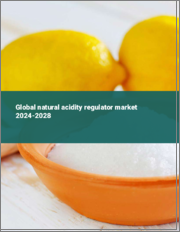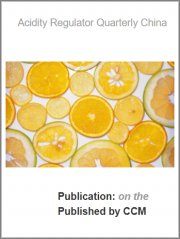
|
시장보고서
상품코드
1541368
산도 조절제 시장 보고서 : 제품, 공급원, 용도, 지역별(2024-2032년)Acidity Regulators Market Report by Product, Source, Application, and Region 2024-2032 |
||||||
세계 산도 조절제 시장 규모는 2023년 67억 달러에 달했습니다. 향후 IMARC Group은 2024-2032년까지 4.3%의 연평균 성장률(CAGR)을 보이며 2032년까지 시장 규모가 99억 달러에 달할 것으로 예상하고 있습니다. 가공식품 및 식음료에 대한 수요 증가, 건강 및 웰빙에 대한 소비자의 인식 증가, 유기농 및 천연 식품 소비 급증 등이 시장을 주도하는 주요 요인입니다.
산미료라고도 알려진 산도 조절제는 다양한 식품 및 음료의 산도 수준을 조정하고 조절하는 데 중요한 역할을 합니다. 산도 조절제는 원하는 효과에 따라 pH 수준을 높이거나 낮추는 방식으로 작동합니다. 산도 조절제에서 가장 일반적으로 사용되는 성분으로는 구연산, 젖산, 인산, 아세트산 등이 있습니다. 산도 조절제의 주요 목적은 산성과 알칼리성의 균형을 맞추고 부패를 방지하고 제품의 안정성을 유지하는 것입니다. 탄산음료, 과자, 소스, 보존 식품의 제조에 널리 사용됩니다. 산도 조절제의 장점은 제품 보존 기간 개선, 맛과 질감 개선, 미생물 증식 억제 능력 등이 있습니다. 산도 조절제에는 유기산, 무기산, 광산, 완충제 등 다양한 종류가 있으며 각기 다른 용도가 있습니다. 예를 들어, 구연산은 청량음료에 많이 사용되며, 인산은 콜라에 선호됩니다. 반면 인산과 같은 무기산은 탄산음료에 사용됩니다.
산도 조절제 시장 동향
가공 식품 및 음료에 대한 수요가 증가함에 따라 pH 수준을 유지하고 풍미를 개선하며 보존 기간을 연장하기 위한 산도 조절제에 대한 수요가 급증하고 있으며, 이는 시장 전망을 밝게 만드는 주요 요인 중 하나입니다. 또한 건강과 웰빙에 대한 소비자의 인식이 높아짐에 따라 보존을 위해 산도 조절제가 필요한 유기농 및 천연 식품의 소비가 증가하여 시장 성장을 더욱 촉진하고 있습니다. 이와는 별도로, 특히 신흥 경제국에서 식음료(F&B) 산업의 확장은 제조업체들이 소비자의 증가하는 수요를 충족시키기 위해 노력하고 있기 때문에 시장을 주도하고 있습니다. 또한, 전 세계 규제 당국의 엄격한 식품 안전 규정 및 표준으로 인해 음료 및 식품 회사는 산도 조절제를 사용해야 하며, 이는 시장 성장을 가속화하고 있습니다. 또한, 간편식 및 RTD(Ready-To-Drink) 음료의 인기 증가와 소비자의 바쁜 라이프스타일이 결합되어 시장 성장을 촉진하고 있습니다. 또한, 제약 산업에서 산도 조절제 채택 증가, 클린 라벨 제품에 대한 수요 증가, 생산 기술의 급속한 기술 발전이 시장 성장을 촉진하고 있습니다. 그 외 산도 조절제의 새로운 용도의 출현, 다양한 제품 옵션의 가용성, 국제 식품 무역의 증가 추세 등이 시장 성장을 적극적으로 촉진하고 있습니다.
본 보고서에서 다루는 주요 질문들
- 2023년 세계 산도 조절제 시장 규모는?
- 2024-2032년 세계 산도 조절제 시장 성장률 전망은?
- 세계 산도 조절제 시장을 이끄는 주요 요인은 무엇인가?
- COVID-19가 세계 산도 조절제 시장에 미치는 영향은?
- 세계 산도 조절제 시장의 제품별 분류는?
- 세계 산도 조절제 시장의 공급원별 시장 현황은?
- 세계 산도 조절제 시장의 용도별 시장 현황은?
- 세계 산도 조절제 시장의 주요 지역은?
- 세계 산도 조절제 시장의 주요 진입 기업은?
목차
제1장 서문
제2장 조사 범위와 조사 방법
- 조사 목적
- 이해관계자
- 데이터 소스
- 1차 정보
- 2차 정보
- 시장 추정
- 상향식 접근
- 하향식 접근
- 조사 방법
제3장 주요 요약
제4장 소개
- 개요
- 주요 업계 동향
제5장 세계의 산도 조절제 시장
- 시장 개요
- 시장 실적
- COVID-19의 영향
- 시장 예측
제6장 시장 내역 : 제품별
- 구연산
- 인산
- 아세트산
- 말레인산
- 젖산
- 기타
제7장 시장 내역 : 공급원별
- 천연
- 합성
제8장 시장 내역 : 용도별
- 음료
- 소스, 조미료, 드레싱
- 가공식품
- 베이커리
- 제과
- 기타
제9장 시장 내역 : 지역별
- 북미
- 미국
- 캐나다
- 아시아태평양
- 중국
- 일본
- 인도
- 한국
- 호주
- 인도네시아
- 기타
- 유럽
- 독일
- 프랑스
- 영국
- 이탈리아
- 스페인
- 러시아
- 기타
- 라틴아메리카
- 브라질
- 멕시코
- 기타
- 중동 및 아프리카
- 시장 동향
- 시장 내역 : 국가별
- 시장 예측
제10장 SWOT 분석
- 개요
- 강점
- 약점
- 기회
- 위협
제11장 밸류체인 분석
제12장 Porter's Five Forces 분석
- 개요
- 구매자의 교섭력
- 공급 기업의 교섭력
- 경쟁 정도
- 신규 참여업체의 위협
- 대체품의 위협
제13장 가격 분석
제14장 경쟁 상황
- 시장 구조
- 주요 기업
- 주요 기업 개요
- Archer Daniels Midland Company
- Bartek Ingredients Inc.
- Cargill Incorporated
- Celrich Products Pvt. Ltd.
- Chemelco International B.V.
- Corbion N.V.
- F.B.C Industries Inc.
- Foodchem International Corporation
- Jungbunzlauer Suisse AG
- Tate & Lyle Plc
- Univar Solutions Inc.
The global acidity regulators market size reached US$ 6.7 Billion in 2023. Looking forward, IMARC Group expects the market to reach US$ 9.9 Billion by 2032, exhibiting a growth rate (CAGR) of 4.3% during 2024-2032. The increasing demand for processed foods and beverages, growing awareness among consumers regarding health and wellness, and the surging consumption of organic and natural food products are some of the key factors driving the market.
Acidity regulators, also known as acidulants, play a vital role in adjusting and controlling the acidity levels of various food and beverage products. They work by increasing or decreasing the pH levels, depending on the desired effect. The most commonly used components in acidity regulators include citric acid, lactic acid, phosphoric acid, and acetic acid. The primary purpose of acidity regulators is to balance acidity and alkalinity, preventing spoilage and maintaining product stability. They are widely used in producing carbonated drinks, confectioneries, sauces, and preserved foods. The advantages of acidity regulators include improved product shelf life, enhanced taste and texture, and the ability to control microbial growth. There are various types of acidity regulators available, including organic acids, inorganic acids, mineral acids, and buffering agents, each with its own set of applications. For instance, citric acid is commonly used in soft drinks, while phosphoric acid is preferred for colas. On the other hand, inorganic acids, such as phosphoric acid, find applications in carbonated drinks.
Acidity Regulators Market Trends:
The increasing demand for processed foods and beverages has surged the need for acidity regulators to maintain pH levels, enhance flavor, and extend shelf life, which represents one of the primary factors creating a positive outlook for the market. Moreover, the growing awareness among consumers regarding health and wellness has led to an increase in the consumption of organic and natural food products, which require acidity regulators for preservation, further propelling the market growth. Apart from this, the expanding food and beverage (F&B) industry, especially in emerging economies, drives the market as manufacturers strive to meet the rising consumer demands. Additionally, stringent food safety regulations and standards imposed by regulatory authorities across the globe have compelled food and beverage companies to utilize acidity regulators, which, in turn, is accelerating the market growth. Furthermore, the rising popularity of convenience foods and ready-to-drink (RTD) beverages, coupled with the hectic lifestyles of consumers, are propelling the market growth. Furthermore, the increasing adoption of acidity regulators in the pharmaceutical industry, the rising demand for clean-label products, and rapid technological advancements in production techniques are bolstering the market growth. Other factors, such as the emergence of new applications for acidity regulators, the availability of a wide range of product options, and the growing trend of international food trade, are positively supporting the market growth.
Key Market Segmentation:
IMARC Group provides an analysis of the key trends in each sub-segment of the global acidity regulators market report, along with forecasts at the global, regional and country level from 2024-2032. Our report has categorized the market based on product, source and application.
Product Insights:
Citric Acid
Phosphoric acid
Acetic Acid
Maleic Acid
Lactic Acid
Others
The report has provided a detailed breakup and analysis of the global acidity regulators market based on the product. This includes citric acid, phosphoric acid, acetic acid, maleic acid, lactic acid, and others. According to the report, citric acid accounted for the largest market share.
Source Insights:
Natural
Synthetic
The report has provided a detailed breakup and analysis of the global acidity regulators market based on source. This includes natural and synthetic. According to the report, natural accounted for the largest market share.
Application Insights:
Beverages
Sauces, Condiments, and Dressings
Processed Food
Bakery
Confectionery
Others
The report has provided a detailed breakup and analysis of the global acidity regulators market based on the application. This includes beverages, sauces, condiments, and dressings, processed food, bakery, confectionery, and others. According to the report, beverages accounted for the largest market share.
Regional Insights:
North America
United States
Canada
Asia-Pacific
China
Japan
India
South Korea
Australia
Indonesia
Others
Europe
Germany
France
United Kingdom
Italy
Spain
Russia
Others
Latin America
Brazil
Mexico
Others
Middle East and Africa
The report has also provided a comprehensive analysis of all the major regional markets, which include North America (the United States and Canada); Europe (Germany, France, the United Kingdom, Italy, Spain, Russia, and others); Asia Pacific (China, Japan, India, South Korea, Australia, Indonesia, and others); Latin America (Brazil, Mexico, and others); and the Middle East and Africa. As per the report, Asia Pacific was the largest market for acidity regulators. Some of the factors driving the Asia Pacific acidity regulators market included the rapidly expanding food and beverage sector, increasing adoption of acidity regulators in the pharmaceutical industry, and the rising demand for clean-label products.
Competitive Landscape:
The report has also provided a comprehensive analysis of the competitive landscape in the global acidity regulators market. Competitive analysis such as market structure, market share by key players, player positioning, top winning strategies, competitive dashboard, and company evaluation quadrant has been covered in the report. Also, detailed profiles of all major companies have been provided. Some of the companies covered include Archer Daniels Midland Company, Bartek Ingredients Inc., Cargill Incorporated, Celrich Products Pvt. Ltd., Chemelco International B.V., Corbion N.V., F.B.C Industries Inc., Foodchem International Corporation, Jungbunzlauer Suisse AG, Tate & Lyle Plc, and Univar Solutions Inc., etc. Kindly note that this only represents a partial list of companies, and the complete list has been provided in the report.
Key Questions Answered in This Report
- 1. What was the size of the global acidity regulators market in 2023?
- 2. What is the expected growth rate of the global acidity regulators market during 2024-2032?
- 3. What are the key factors driving the global acidity regulators market?
- 4. What has been the impact of COVID-19 on the global acidity regulators market?
- 5. What is the breakup of the global acidity regulators market based on the product?
- 6. What is the breakup of the global acidity regulators market based on the source?
- 7. What is the breakup of the global acidity regulators market based on the application?
- 8. What are the key regions in the global acidity regulators market?
- 9. Who are the key players/companies in the global acidity regulators market?
Table of Contents
1 Preface
2 Scope and Methodology
- 2.1 Objectives of the Study
- 2.2 Stakeholders
- 2.3 Data Sources
- 2.3.1 Primary Sources
- 2.3.2 Secondary Sources
- 2.4 Market Estimation
- 2.4.1 Bottom-Up Approach
- 2.4.2 Top-Down Approach
- 2.5 Forecasting Methodology
3 Executive Summary
4 Introduction
- 4.1 Overview
- 4.2 Key Industry Trends
5 Global Acidity Regulators Market
- 5.1 Market Overview
- 5.2 Market Performance
- 5.3 Impact of COVID-19
- 5.4 Market Forecast
6 Market Breakup by Product
- 6.1 Citric Acid
- 6.1.1 Market Trends
- 6.1.2 Market Forecast
- 6.2 Phosphoric acid
- 6.2.1 Market Trends
- 6.2.2 Market Forecast
- 6.3 Acetic Acid
- 6.3.1 Market Trends
- 6.3.2 Market Forecast
- 6.4 Maleic Acid
- 6.4.1 Market Trends
- 6.4.2 Market Forecast
- 6.5 Lactic Acid
- 6.5.1 Market Trends
- 6.5.2 Market Forecast
- 6.6 Others
- 6.6.1 Market Trends
- 6.6.2 Market Forecast
7 Market Breakup by Source
- 7.1 Natural
- 7.1.1 Market Trends
- 7.1.2 Market Forecast
- 7.2 Synthetic
- 7.2.1 Market Trends
- 7.2.2 Market Forecast
8 Market Breakup by Application
- 8.1 Beverages
- 8.1.1 Market Trends
- 8.1.2 Market Forecast
- 8.2 Sauces, Condiments, and Dressings
- 8.2.1 Market Trends
- 8.2.2 Market Forecast
- 8.3 Processed Food
- 8.3.1 Market Trends
- 8.3.2 Market Forecast
- 8.4 Bakery
- 8.4.1 Market Trends
- 8.4.2 Market Forecast
- 8.5 Confectionery
- 8.5.1 Market Trends
- 8.5.2 Market Forecast
- 8.6 Others
- 8.6.1 Market Trends
- 8.6.2 Market Forecast
9 Market Breakup by Region
- 9.1 North America
- 9.1.1 United States
- 9.1.1.1 Market Trends
- 9.1.1.2 Market Forecast
- 9.1.2 Canada
- 9.1.2.1 Market Trends
- 9.1.2.2 Market Forecast
- 9.1.1 United States
- 9.2 Asia-Pacific
- 9.2.1 China
- 9.2.1.1 Market Trends
- 9.2.1.2 Market Forecast
- 9.2.2 Japan
- 9.2.2.1 Market Trends
- 9.2.2.2 Market Forecast
- 9.2.3 India
- 9.2.3.1 Market Trends
- 9.2.3.2 Market Forecast
- 9.2.4 South Korea
- 9.2.4.1 Market Trends
- 9.2.4.2 Market Forecast
- 9.2.5 Australia
- 9.2.5.1 Market Trends
- 9.2.5.2 Market Forecast
- 9.2.6 Indonesia
- 9.2.6.1 Market Trends
- 9.2.6.2 Market Forecast
- 9.2.7 Others
- 9.2.7.1 Market Trends
- 9.2.7.2 Market Forecast
- 9.2.1 China
- 9.3 Europe
- 9.3.1 Germany
- 9.3.1.1 Market Trends
- 9.3.1.2 Market Forecast
- 9.3.2 France
- 9.3.2.1 Market Trends
- 9.3.2.2 Market Forecast
- 9.3.3 United Kingdom
- 9.3.3.1 Market Trends
- 9.3.3.2 Market Forecast
- 9.3.4 Italy
- 9.3.4.1 Market Trends
- 9.3.4.2 Market Forecast
- 9.3.5 Spain
- 9.3.5.1 Market Trends
- 9.3.5.2 Market Forecast
- 9.3.6 Russia
- 9.3.6.1 Market Trends
- 9.3.6.2 Market Forecast
- 9.3.7 Others
- 9.3.7.1 Market Trends
- 9.3.7.2 Market Forecast
- 9.3.1 Germany
- 9.4 Latin America
- 9.4.1 Brazil
- 9.4.1.1 Market Trends
- 9.4.1.2 Market Forecast
- 9.4.2 Mexico
- 9.4.2.1 Market Trends
- 9.4.2.2 Market Forecast
- 9.4.3 Others
- 9.4.3.1 Market Trends
- 9.4.3.2 Market Forecast
- 9.4.1 Brazil
- 9.5 Middle East and Africa
- 9.5.1 Market Trends
- 9.5.2 Market Breakup by Country
- 9.5.3 Market Forecast
10 SWOT Analysis
- 10.1 Overview
- 10.2 Strengths
- 10.3 Weaknesses
- 10.4 Opportunities
- 10.5 Threats
11 Value Chain Analysis
12 Porters Five Forces Analysis
- 12.1 Overview
- 12.2 Bargaining Power of Buyers
- 12.3 Bargaining Power of Suppliers
- 12.4 Degree of Competition
- 12.5 Threat of New Entrants
- 12.6 Threat of Substitutes
13 Price Analysis
14 Competitive Landscape
- 14.1 Market Structure
- 14.2 Key Players
- 14.3 Profiles of Key Players
- 14.3.1 Archer Daniels Midland Company
- 14.3.1.1 Company Overview
- 14.3.1.2 Product Portfolio
- 14.3.1.3 Financials
- 14.3.1.4 SWOT Analysis
- 14.3.2 Bartek Ingredients Inc.
- 14.3.2.1 Company Overview
- 14.3.2.2 Product Portfolio
- 14.3.3 Cargill Incorporated
- 14.3.3.1 Company Overview
- 14.3.3.2 Product Portfolio
- 14.3.3.3 SWOT Analysis
- 14.3.4 Celrich Products Pvt. Ltd.
- 14.3.4.1 Company Overview
- 14.3.4.2 Product Portfolio
- 14.3.5 Chemelco International B.V.
- 14.3.5.1 Company Overview
- 14.3.5.2 Product Portfolio
- 14.3.6 Corbion N.V.
- 14.3.6.1 Company Overview
- 14.3.6.2 Product Portfolio
- 14.3.6.3 Financials
- 14.3.7 F.B.C Industries Inc.
- 14.3.7.1 Company Overview
- 14.3.7.2 Product Portfolio
- 14.3.8 Foodchem International Corporation
- 14.3.8.1 Company Overview
- 14.3.8.2 Product Portfolio
- 14.3.9 Jungbunzlauer Suisse AG
- 14.3.9.1 Company Overview
- 14.3.9.2 Product Portfolio
- 14.3.10 Tate & Lyle Plc
- 14.3.10.1 Company Overview
- 14.3.10.2 Product Portfolio
- 14.3.10.3 Financials
- 14.3.10.4 SWOT Analysis
- 14.3.11 Univar Solutions Inc.
- 14.3.11.1 Company Overview
- 14.3.11.2 Product Portfolio
- 14.3.11.3 Financials
- 14.3.11.4 SWOT Analysis
- 14.3.1 Archer Daniels Midland Company












